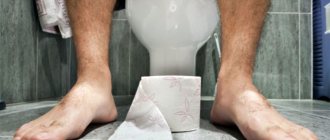What is Restless Legs Syndrome?
Restless legs syndrome is a pathological condition consisting of an obsessive desire to move the legs, caused by a number of certain unpleasant sensations in the lower extremities. These sensations with restless legs syndrome can be pain or aching in the muscles, as well as itching, a burning sensation, crawling distension or twitching in the lower extremities.
Restless legs syndrome
These subjective symptoms more often occur at night or when taking a horizontal body position and relaxing. A significant weakening of the above symptoms occurs with contraction of the muscles of the lower extremities. Therefore, patients with restless legs syndrome have an obsessive need to move the lower extremities.
Physiological myoclonus
The vast majority of people experience hypnagogic startle. If the manifestations of myoclonus do not last long at the beginning of falling asleep, then they do not pay attention to this. In the morning there are no memories of short-term cramps. Only loved ones can see and tell this.
USEFUL INFORMATION: The head and neck sweats during sleep in an adult: causes
Among neurologists, one theory of the occurrence of nocturnal myoclonus is most common. It lies in the fact that the brain perceives as a danger the slowdown in the body’s vital processes during the transition to sleep. However, this is not the only opinion; there are several more versions that deserve attention:
- It is possible that myoclonic spasms occur when sleep phases alternate. The sleep process is complex and consists of several phases: slow, fast, shallow and deep sleep. During the transition from one phase to another, a sharp change in brain activity indicators occurs, which provokes the occurrence of impulses in many channels of the nervous system simultaneously. The result of this is the appearance of nocturnal myoclonus.
- Some experts in psychology and neurology are of the opinion that shuddering when falling asleep occurs due to excessive stress on the nervous system. During the day, a person experiences many events, experiencing a lot of different feelings. Negative emotions cause stress. And its accumulation leads to overload of the nervous system, which during sleep seems to “replay” unpleasant situations again.
- Another theory for the occurrence of hypnagogic shudder is an insufficient amount of a trace element such as potassium in the body. It is part of all soft tissues, bones, blood, and its deficiency negatively affects the functioning of the liver, brain, nervous and cardiovascular systems. If tests show that there is little of it in the body, the doctor will prescribe appropriate medications.
- The cause of body trembling when falling into a doze can be a nervous tic, which is a monotonous involuntary rapid contraction of muscle tissue. In children, it usually goes away with age. Adults should undergo a course of treatment that will reduce severe symptoms.
- Myoclonic spasms can be triggered by excessive physical exertion. This is especially true for older people, as well as those who do not have appropriate physical training.
Whatever causes short-term nocturnal myoclonus, such symptoms are not a pathology. If there are signs of physiological myoclonus, then do not panic - they are considered a natural component of healthy sleep.
Treatment for restless legs syndrome
Taking multivitamins, anticonvulsants, and giving up bad habits often help get rid of restless leg syndrome.
Restless legs syndrome is a fairly common complaint in patients suffering from varicose veins for a long time. Chronic venous insufficiency, which occurs with varicose veins, disrupts the electrolyte balance in the tissues of the lower extremities, leading to the appearance of restless legs syndrome. This condition is well known to many patients with varicose veins. In some cases, wearing compression stockings may help, providing some relief. However, after some time, restless legs syndrome returns. Only radical treatment of varicose veins helps patients completely get rid of restless legs syndrome.
Restless legs syndrome is not a symptom exclusively of varicose veins. There are many other causes of restless legs syndrome. It is very likely that a therapist or neurologist will be able to help. However, if you have restless legs syndrome, it is better to visit a phlebologist and undergo a diagnosis of the venous system of the lower extremities.
Diagnosis of restless legs syndrome
If you have varicose veins, lifestyle changes and vitamin supplements will not be able to completely rid you of restless legs syndrome. Only good treatment for varicose veins will be an effective remedy for restless legs syndrome in this situation.
Hope for the future
Although there is no targeted treatment for this condition, researchers are working to learn more about RLS.
“Even though scientists have discovered these facts, treating RLS remains challenging. Since iron deficiency occurs in the brain, it is not easy to get it there. We are looking at iron treatments, trying oral and intravenous iron. Sometimes treatment doesn't work. There is an assumption that iron deficiency can change genetics or other processes in the body, so even after replenishing the deficiency, the patient's condition remains the same. We are working on new iron therapy treatments for people who do not respond to standard therapy. In addition, other treatments for RLS are being explored.”
Patient Questions About Restless Legs Syndrome
My legs twitch when falling asleep, what should I do?
If your legs twitch when falling asleep, you need to figure out the cause of this phenomenon. Convulsive contractions of the muscles of the lower extremities can be caused by a number of reasons. First you need to visit the following specialists: a neurologist and phlebologist. An ultrasound duplex examination of the veins of the lower extremities must be performed. Having understood the cause of the condition, it will be possible to completely get rid of convulsive twitching at night.
How to treat restless legs syndrome?
To understand how to treat restless legs syndrome, it is necessary to find out the cause of its occurrence. This will require consultations with the following specialists: a neurologist, phlebologist and therapist.
My legs twist a lot at night, what should I do?
If you experience severe leg cramps at night, seek medical attention. A very common cause of this condition is chronic venous insufficiency, complicating varicose veins.
Pain in legs at night when lying down, which doctor should I go to?
If you have pain in your legs at night when lying down, the first doctor you should visit is a phlebologist. At the beginning, it is necessary to exclude venous pathology. Perhaps a phlebologist will completely solve your problem.
The hypothalamus is to blame for everything
In the intermediate part of the brain there is a section called the hypothalamus. This area is formed by a large number of cell blocks and is responsible for the normal functioning of many body systems. For example: it regulates metabolic processes, controls the endocrine, cardiovascular, and also controls the autonomic and many other systems. When a person falls asleep, the first phase of sleep begins, a decrease in body temperature and a drop in blood pressure occur. The breathing pattern changes: a significantly smaller volume of air is inhaled into the lungs and exhaled. This whole complex of changes in the body’s performance indicators is similar to the processes characteristic of death.
The hypothalamus regards this situation as dangerous, and in order to “resurrect” the body, return all its systems to an active state, it sends a discharge and creates a shake-up. Result: a sharp increase in muscle tone, expressed in body trembling.
Hypnagogic startle has no age, social or gender restrictions. This syndrome can manifest itself in one form or another in each of us. How can you determine whether you should worry and make an appointment with a neurologist if you notice myoclonic seizures or not? The determining moment is the duration of the startle in sleep. If this phenomenon is short-term, sometimes present in the initial phase of sleep, then there is no need to worry. This level of myoclonus is within the normal range and does not threaten health and proper sleep.
Everything is much more serious if myoclonic spasms accompany sleep throughout the night. This pathology does not allow you to get enough sleep, the body does not recover. Pathological myoclonus indicates significant health problems and can provoke the emergence of new diseases. In such circumstances, it is, of course, impossible to do without qualified medical care. The sooner treatment begins, the more effective its results will be.
Sleep paralysis
Myoclonus can also manifest as sleep paralysis.
Its symptoms have been familiar to people since ancient times, and they are covered in various mystical stories. A patient suffering from this disorder is conscious, but cannot even move. This state is accompanied by increasing panic, fear, and visions. It was the visions that created the mystical infernal flair for this disease. A patient in a state of sleep paralysis sees monsters, aliens, hears otherworldly voices, chilling sounds, etc. The condition is aggravated by a feeling of suffocation and heaviness in the chest area. At the same time, the patient trembles, his pulse quickens, and breathing becomes difficult. Fortunately, all these conditions accompanying sleep paralysis do not threaten your health, but they do force you to endure several very unpleasant minutes. The cause of the manifestations of the syndrome can be various types of diseases of the nervous system. Their range is wide: from manic-depressive psychosis to somnambulism and narcolepsy. Although most often sleep paralysis occurs due to an imbalance in the nervous system.
Possible reasons:
- frequent severe stress;
- drug addiction or alcoholism;
- chronic lack of sleep;
- overdose or many months of taking certain medications (tranquilizers, antidepressants).
In addition to the listed factors for the occurrence of the syndrome, sleep paralysis can be inherited. In most cases, drug treatment is not required. After confirming the diagnosis, doctors recommend changing your daily routine, sleeping at least eight hours a day, leading a mobile, active lifestyle, avoiding stress, giving yourself a massage, etc.
Symptoms in children
Parents can pay attention to how the baby twitches its legs during the transition to sleep. Don't panic. It should be remembered that the baby’s sleep structure is different from ours. This is explained by age and different stages of development of the body - the older the person, the more complex all the processes. The duration of deep sleep for an adult is two to three hours, while for an infant it lasts approximately one 50-60 minutes. Deep sleep is replaced by shallow sleep, and during this transition the baby may shudder. That is, twitching during the superficial phase indicates that the child is simply dreaming. Myoclonus can also occur in children during adolescence. This period of life is characterized by active reorganization of the body, so sometimes malfunctions in the functioning of the nervous system can occur.
Pathological myoclonus
If a short trembling of the legs during the transition to sleep should not cause fear and anxiety, then myoclonic spasms during the day during wakefulness are a reason to be concerned. Sometimes, after experiencing serious stress, which necessarily manifests itself in overload of the nervous system, some manifestations of daytime myoclonus are acceptable. If this does not occur chronically and there are no relapses, then there is no cause for alarm yet. However, when the syndrome manifests itself repeatedly during the day, and then it repeats in subsequent days, then, most likely, pathology can be assumed.
The causes of pathological myoclonus can be different. Frequently repeating progressive daytime and nighttime hypnagogic seizures are one of the signs of epilepsy. Moreover, they can affect both local areas and the entire body. Various manifestations can provoke an attack, for example: severe thunderstorms, lightning strikes, loud music with flashing lights. Doctors explain the causes of epileptic seizures as an insufficient amount of oxygen entering the brain, as well as degeneration of brain cells.
There is also an essential variant of myoclonus, which in patients begins in childhood, being a hereditary disease.
In addition to the above, there are a number of conditions against which the symptoms of pathological myoclonus may appear:
- Viral encephalitis. When the virus enters the brain, inflammation begins. The carriers are already sick people or infected insects; sometimes the disease is caused by the herpes simplex virus.
- Diseases affecting the spinal cord, cerebellum, brain stem, which are transmitted hereditarily.
- Storage reticulosis (storage diseases). A complex of hereditary or acquired (acquired) pathological conditions that cause metabolic problems, damage to the cardiovascular or central nervous system.
- Degenerative processes in the basal ganglia, which are located in the white matter of the brain.
- A sharp disturbance in the blood circulation of the brain (stroke). Signs of illness may include sudden fainting or paralysis.
- An inflammatory process in nerve endings that affects fibers. Occurs due to diseases of various internal organs. Damage to nerve fibers can also be the result of poisoning with a toxic substance or an overdose of a medication.
USEFUL INFORMATION: Insomnia torments: causes, symptoms, consequences
Only specialized doctors can determine the cause of pathological myoclonus. As a rule, if a disease is suspected, an electroencephalogram is prescribed and blood is given for tests. If signs of pathological myoclonus are detected, you should not postpone going to the medical center; advanced diseases are more difficult to treat and take longer.
Diagnostics
Clinical examination data, supported by the results of additional methods, help to understand what disease caused weakness in the legs. The list of diagnostic procedures is determined by a neurologist based on information obtained during a survey and neurological examination of the patient. The following tests may be performed:
- Blood tests.
In the hemogram, attention is paid to red blood counts, leukocyte count, and ESR. Biochemical analysis can detect hormonal or electrolyte imbalances, muscle enzymes, and specific antibodies. - Radiography.
The condition of the bone structures of the spine and skull can be assessed using conventional photographs taken in two projections. But the study has low resolution and does not detect changes in soft tissues. - Tomography.
CT is the preferred method for visualizing recent strokes, tumors, hematomas, and posterior fossa fractures. Diffuse pathology of the substance of the spinal cord and brain is more accurately determined by magnetic resonance imaging. - Myelography.
The patency of the cervical canal is determined by introducing a radiopaque contrast agent into the subarachnoid space. Myelography is indicated for intervertebral hernias, spinal injuries, and tumors. - Electroneuromyography.
Diseases accompanied by nerve conduction disorders are diagnosed using ENMG data. During the study, the peripheral nerve is stimulated with electrical impulses and the muscle response is subsequently recorded.
To identify vascular diseases, ultrasound angioscanning and rheovasography are prescribed. Endocrinopathies require ultrasound examination of the thyroid and parathyroid glands, adrenal glands; in persons with myasthenia gravis, the size of the thymus is assessed. Diagnosis of hereditary diseases is carried out using cytogenetic and molecular genetic tests.
Foot massage









